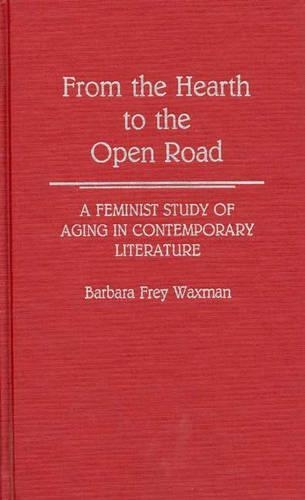
From the Hearth to the Open Road: A Feminist Study of Aging in Contemporary Literature
(Hardback)
Publishing Details
From the Hearth to the Open Road: A Feminist Study of Aging in Contemporary Literature
By (Author) Barbara F. Waxman
Bloomsbury Publishing PLC
Praeger Publishers Inc
11th May 1990
United States
Classifications
Tertiary Education
Non Fiction
Literary studies: c 1900 to c 2000
Gender studies: women and girls
820.9352042
Physical Properties
Hardback
224
Width 140mm, Height 216mm
397g
Description
This literary critical book deals exclusively with contemporary fiction by women that focuses on ageing of women. It discusses the emergence of a new fictional genre, the novel of ripening or "Reifungsroman". This emerging genre about the ageing heroine reconceptualizes middle and old age for women, taking it from a formerly stereotypical state of passivity and deterioration (by the hearthside) into one of adventure, growth, self-discovery, self-affirmation, and integration (on the open road). The book contains a bibliography of twentieth-century popular periodical articles on ageing (Canadian, American and British); literary critical articles on ageing in the fiction of Doris Lessing, Alice Adams, Paule Marshall, Elizabeth Taylor, Barbara Pym, May Sarton, and Margaret Laurence, as well as general literary critical works on these authors and some general (non-literary) studies of ageing, often from a feminist framework (such as Simone de Beauvoir's "The Coming of Age"). Using a feminist theoretical approach, with some influence from social literary critics such as Lentricchia and Said, the book surveys, in the first chapter, selected popular magazine articles written over this century. The next chapter analyzes fiction on middle-aged women, in works by Doris Lessing and Alice Adams. Chapter three analyzes "young-old" women, in works by Barbara Pym, Elizabeth Taylor and Paule Marshall. The final chapter looks at "frail, or dependent old" women, in works by May Sarton and Margaret Laurence. This work should interest students and scholars engaged in the study of literary criticism, women's studies in literature, gerontology, the life-cycle in literature, and contemporary women in literature.
Reviews
Waxman traces the changing image of aging women in popular magazines and fiction. She asserts that a new genre is emerging, which she dubs the Reifungsroman, or 'novel of ripening.' She compares this to the more familiar term Bildungsroman, as each kind of fiction portrays a character's growth, but at a different stage of life. The characteristics of this new genre, according to Waxman, include a confessional tone, a rambling narrative, exploration of sexual passion, a journey/quest motif, the desire to name, and dreams/flashbacks that allow the character to come to terms with her past. The establishment of this new genre and the creation of a bibliography are the most valuable aspects of the book. Waxman's analysis of individual works of fiction is competent but lacklustre, offering few new insights. She includes the following writers: Doris Lessing, Alice Adams, Elizabeth Taylor, Barbara Pym, Paule Marshall, Margaret Laurence, and May Sarton; she devotes her opening chapter to the depiction of old age in periodical literature of 1890-1920 and of 1950-1980s, establishing a backdrop for her discussion of contemporary fiction. The overall impact of Waxman's book is to point out a rather dramatic move away from ageism in recent fiction by and about women.-Choice
"Waxman traces the changing image of aging women in popular magazines and fiction. She asserts that a new genre is emerging, which she dubs the Reifungsroman, or 'novel of ripening.' She compares this to the more familiar term Bildungsroman, as each kind of fiction portrays a character's growth, but at a different stage of life. The characteristics of this new genre, according to Waxman, include a confessional tone, a rambling narrative, exploration of sexual passion, a journey/quest motif, the desire to name, and dreams/flashbacks that allow the character to come to terms with her past. The establishment of this new genre and the creation of a bibliography are the most valuable aspects of the book. Waxman's analysis of individual works of fiction is competent but lacklustre, offering few new insights. She includes the following writers: Doris Lessing, Alice Adams, Elizabeth Taylor, Barbara Pym, Paule Marshall, Margaret Laurence, and May Sarton; she devotes her opening chapter to the depiction of old age in periodical literature of 1890-1920 and of 1950-1980s, establishing a backdrop for her discussion of contemporary fiction. The overall impact of Waxman's book is to point out a rather dramatic move away from ageism in recent fiction by and about women."-Choice
Author Bio
BARBARA FREY WAXMAN is Associate Professor of English and Director of Graduate Studies on nineteenth-century British literature, contemporary literature, ethnic literature, and the feminist pedagogy in the teaching of literature at the University of North Carolina, Wilmington. She is the author of numerous publications.
